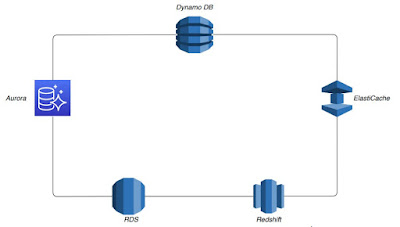Here we are resuming our last blog by intruding and explaining the AWS Auro, AWS DynamoDB, and AWS ElastiCache Database services.
What Is Amazon AWS Aurora Database?
Amazon Aurora is fully managed by Amazon RDS. It is a relational database engine built for the cloud. Amazon Aurora is also completely compatible with MySQL. Since Amazon Aurora is fully managed by RDS, all administrative tasks such as database setup, patching, backups, and more are automated.
Following are some of the benefits of using Amazon Aurora:
- It provides high performance and scalability.
- It’s highly secure.
- It offers high availability and durability.
- It’s fully managed.
What Is Amazon AWS DynamoDB?
Amazon DynamoDB is a fast, fully managed, and flexible NoSQL database. It also supports document-based data. AWS affirms that DynamoDB delivers single-digit millisecond performance at any scale. DynamoDB comes with built-in Security, Backup, and Restore features.
Since DynamoDB is a NoSQL database, it doesn’t require any schema. In DynamoDB, there are basically three core components:
Tables:
The collection of data is called a table in DynamoDB. It’s not a structured table with a fixed number of rows and columns.
The collection of data is called a table in DynamoDB. It’s not a structured table with a fixed number of rows and columns.
Items:
Tables in DynamoDB contain one or more items. Items are made up of a group of uniquely identifiable attributes.
Attributes:
Attributes are the data elements or values that reside in each item. They are equivalent to data values in a relational database that reside in a particular cell of a table.
Following are some of the benefits of using Amazon DynamoDB:
- Easy to set up and manage
- Data is automatically replicated across multiple Availability Zones
- Supports both key–value and document-based data models
What Is AWS ElastiCache?
Amazon ElastiCache is a fully managed caching service that offers high-performance, cost-effective, and scalable caching solutions. Amazon ElastiCache provides two caching engines, namely, Memcached and Redis.
Why Do We Need AWS ElastiCache?
There are various benefits of using Amazon ElastiCache. Besides being easy to set up and deploy, ElastiCache also improves applications’ performance as it reduces disk reads. Following are some of the main reasons why ElastiCache is immensely useful:
- Response time: ElastiCache reduces the response time as it retrieves data from a fast in-memory system. It reduces the dependence on disk-based databases which are usually slower.
- Scalability: Amazon ElastiCache is designed to be able to modify itself, automatically. It can scale out or scale up depending on the fluctuating application requirements.
- Complete management: Amazon ElastiCache is fully managed, so the common administrative tasks such as hardware provisioning, failure recovery, backups, and more are all automated.

Comments
Post a Comment